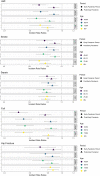Emergency department visits for emergent conditions among older adults during the COVID-19 pandemic
- PMID: 33955546
- PMCID: PMC8242842
- DOI: 10.1111/jgs.17227
Emergency department visits for emergent conditions among older adults during the COVID-19 pandemic
Abstract
Background/objective: Emergency department (ED) visits have declined while excess mortality, not attributable to COVID-19, has grown. It is not known whether older adults are accessing emergency care differently from their younger counterparts. Our objective was to determine patterns of ED visit counts for emergent conditions during the COVID-19 pandemic for older adults.
Design: Retrospective, observational study.
Setting: Observational analysis of ED sites enrolled in a national clinical quality registry.
Participants: One hundred and sixty-four ED sites in 33 states from January 1, 2019 to November 15, 2020.
Main outcome and measures: We measured daily ED visit counts for acute myocardial infarction (AMI), stroke, sepsis, fall, and hip fracture, as well as deaths in the ED, by age categories. We estimated Poisson regression models comparing early and post-early pandemic periods (defined by the Centers for Disease Control and Prevention) to the pre-pandemic period. We report incident rate ratios to summarize changes in visit incidence.
Results: For AMI, stroke, and sepsis, the older (75-84) and oldest old (85+ years) had the greatest decline in visit counts initially and the smallest recovery in the post-early pandemic periods. For falls, visits declined early and partially recovered uniformly across age categories. In contrast, hip fractures exhibited less change in visit rates across time periods. Deaths in the ED increased during the early pandemic period, but then fell and were persistently lower than baseline, especially for the older (75-84) and oldest old (85+ years).
Conclusions: The decline in ED visits for emergent conditions among older adults has been more pronounced and persistent than for younger patients, with fewer deaths in the ED. This is concerning given the greater prevalence and risk of poor outcomes for emergent conditions in this age group that are amenable to time-sensitive ED diagnosis and treatment, and may in part explain excess mortality during the COVID-19 era among older adults.
Keywords: ED visits; care-seeking; emergency care; older adults.
© 2021 The American Geriatrics Society.
Conflict of interest statement
The authors have no conflicts of interest to report.
Figures



References
-
- Kaiser Family Foundation . State COVID‐19 data and policy actions. https://www.kff.org/coronavirus-covid-19/issue-brief/state-covid-19-data.... Accessed January 18, 2020.
Publication types
MeSH terms
Grants and funding
LinkOut - more resources
Full Text Sources
Other Literature Sources
Medical

